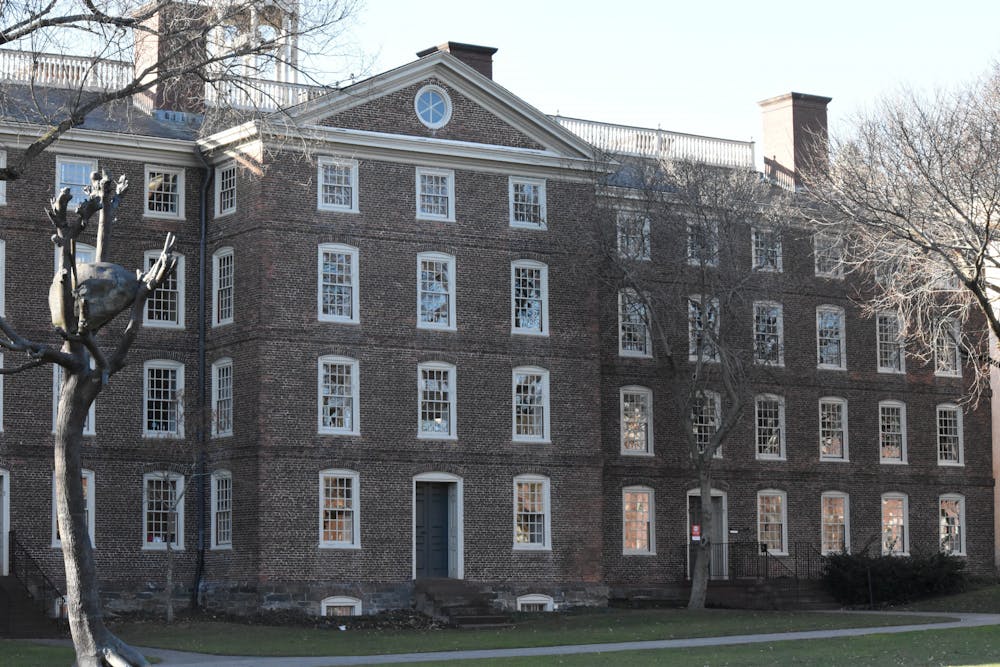In September 2021, President Christina Paxson P’19 P’MD’20 and then-Provost Richard Locke P’18 charged a task force with examining factors that influence the recruitment, retention and promotion of women faculty at the University. Nineteen months later, the Task Force on the Status of Women Faculty published a report of their findings, including eight recommendations to Paxson on how to improve the working conditions for women faculty moving forward.
The Task Force uncovered gender-based disparities in several areas at the University. According to the report, women faculty are underrepresented across all ranks and disciplines at the University, treated inconsistently with Brown’s Code of Conduct and, on average, paid less than men.
According to the report, efforts should be directed toward ensuring equity in the recruitment, retention, compensation and service loads of female and male faculty. The Task Force also recommended that the University provide faculty with better support mechanisms for human resources-related issues that negatively affect women, including a disproportionate distribution of family care responsibilities. The recommendations also call for improved mechanisms to tackle the bias, harassment and misconduct that women faculty face.
Over the next few months, Paxson and incoming Provost Francis J. Doyle will form an implementation team to address the task force’s findings and recommendations, Paxson said in an interview with The Herald.
Report findings: Representation, compensation and campus culture
The Task Force found no gender-based differences among faculty in areas such as access to research resources and tenure rates. The report also noted that there has been progress at the University and across the nation regarding the representation of women faculty.
But many gender-based disparities still prevail today, according to the report.
Based on “conversations and anonymous feedback” from current and former faculty members, the Task Force identified five primary areas for improvement at the University: representation of women faculty, salary by gender, conduct and climate, human resources benefits and information and service load.
Much of the Task Force’s findings are based on University data, which follows federal guidelines mandating binary responses for self-reported gender identity — meaning that the findings were obtained under the parameters of male or female identification.
According to the report, women at Brown continue to be underrepresented in tenured and tenure-track faculty ranks across all disciplines when compared to the national pool of Ph.D. graduates. Relative to men, women are both hired less frequently into faculty positions and are more likely to leave the University, the report noted.
In line with national trends, the representation of women at Brown also declines along the academic career path from PhD to junior faculty at a greater rate than men.
Paxson described this finding as a phenomenon many academics know as “the leaky pipeline,” where women in academia are less likely to go from PhD programs into postdoctoral fellowships, and then less likely to go from postdoctoral fellowships into assistant professor positions.
“What we all have to collectively work on is building this pool of incredibly talented women and giving them the resources and support and encouragement to take their skills and … bring it into universities,” Paxon said.
To bolster the representation of women among the University’s faculty, the Task Force recommended that Brown should apply “affirmative action” strategies to better diversify its applicant pools, recruit senior women scholars to the faculty and enhance its postdoctoral fellowship programs, among other initiatives.
The Task Force also found that the median salaries for women faculty at Brown in the Fiscal Year 2021 were 88% of their male counterparts’ earnings. But when restricted to faculty who started at the University on or after July 1, 2012, the Task Force found no statistically significant, gender-based discrepancies in salaries.
According to the report, the time women faculty spend at the associate professor level — typically two years longer than men— is a contributing factor to such salary differences.
In response to these findings, the Task Force recommended that the University eliminate the gender pay gap within five years by introducing a formal review process of associate professors that ensures they receive consistent feedback on how to meet departmental standards and the criteria for promotion.
Multiple Brown faculty members also cited instances of harassment and bias when surveyed by the Task Force regarding the general campus environment. In the report, women faculty recounted being subjected to hostility, dismissive comments, intimidation and other forms of bullying while working on campus — instances which were inconsistent with Brown’s Code of Conduct but were not covered under Title IX policies.
These issues placed a significant burden on women faculty of color, who reported experiencing tokenism and an overburdened service load because they were consistently asked to represent diversity in the classroom, at events and on University and department committees.
To mitigate such gender-based inequalities, the Task Force recommended that the University introduce Code of Conduct training modules for all staff and establish more consistent procedures for reporting and addressing behaviors that are inconsistent with Brown’s policies.
Next steps and implementation
According to Professor of Neuroscience Diane Lipscombe, who chaired the Task Force on the Status of Women Faculty, the implementation of the Task Force’s recommendations involves both short-term and long-term dedication.
The findings of the report have been made public online, which Paxson said is in line with the University’s commitment to transparency. Paxson added that she hopes the report will spark conversations about the culture of academia both at Brown and among peer institutions.
The University is “setting a standard for what we should all be aspiring to,” Paxson said. But “the fact is, some of the remaining gender inequities in academics cannot be solved at one institutional level.”
Paxson, who recounted leading a similar task force at Princeton prior to her arrival at Brown, expressed excitement about taking action on the report’s findings.
“This is a subject that is near and dear to my heart,” she said. “I am a woman who has been in academics my entire career. I've been in a field where women have been underrepresented.”
The Task Force’s work was “an important process, and it's one that I think every university needs to do,” she added.
At Brown, the report is only a starting point, according to Lipscombe.
“The report is not going to be the difference,” she said. Instead, ensuring that people engage with the report will bring about change, as the discrepancies “are structural, but we are the structure of the University.”
There’s “a deep-seated cultural change that’s needed,” Lipscombe added. And “it’s everyone’s responsibility.”
Paxson noted that the University must remain mindful as it works to implement the Task Force's recommendations. This begins with thinking critically about what faculty members are appointed to the implementation-tracking committee, she said.
“We want our faculty to know that this is important to us, and we’re taking it seriously,” Paxson said. “Not just our current faculty, but the faculty we want to hire in the future.”

Natalie Villacres is a senior staff writer covering the University Hall beat. She is a junior from Queens, New York City, majoring in education and psychology.

Sofia Barnett is a University News editor overseeing the faculty and higher education beat. She is a junior from Texas studying history and English nonfiction and enjoys freelancing in her free time.





